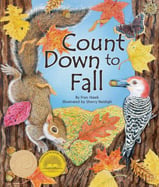Alignment to Standards for CT

| Grade | Number | Standard |
|---|---|---|
| 1 | SC:1.2 | Living things have different structures and behaviors that allow them to meet their basic needs. |
| 1 | SC:1.2.a/b5 | Compare and contrast information about animals and plants found in fiction and nonfiction (FCM) sources. |
| 1 | SC:1.2.a2 | Identify structures and behaviors used by mammals, birds, amphibians, reptiles, fish and insects to move around, breathe and obtain food and water (e.g., legs/wings/fins, gills/lungs, claws/fingers, etc.) |
| 1 | SC:1.2.b | Plants need air, water and sunlight to survive. |
| 1 | SC:1.2.b3 | Sort and classify plants (or plant parts) by observable characteristics (e.g., leaf shape/size, stem or trunk covering, flower or fruit). |
| 2 | SC:2.2.a3 | Describe the functions of roots, stems, leaves, flowers and seeds in completing a plantês life cycle. |
| 3 | SC:3.2.a | Plants and animals have structures and behaviors that help them survive in different environments. |
| 3 | SC:3.2.a1 | Compare and contrast the external features and behaviors that enable different animals and plants to get food, water and sunlight; find mates; and be protected in specific land and water habitats. |
| 3 | SC:3.2.a2 | behaviors such as hibernation, dormancy and migration give species advantages for surviving unfavorable environmental conditions. |
| 3 | SC:3.2.a4 | Evaluate whether an adaptation gives a plant or animal a survival advantage in a given environment. |
| 3 | SC:3.4 | Earth materials provide resources for all living things, but these resources are limited and should be conserved. |
| 4 | SC:4.2.a5 | Distinguish between naturally occurring changes in ecosystems and those caused by human activity. |
| K | SC:K.1 | Objects have properties that can be observed and used to describe similarities and differences. |
| K | SC:K.1.a | Some properties can be observed with the senses, and others can be discovered by using simple tools or tests. |
| K | SC:K.1.a2 | Make scientific observations using the five senses, and distinguish between an objectês observable properties and its name or its uses. |
| K | SC:K.1.a3 | Classify organisms or objects by one and two observable properties and explain the rule used for sorting (e.g., size, color, shape, texture or flexibility). |
| K | SC:K.1.a6 | Count, order and sort objects by their observable properties.6. |
| K | SC:K.2 | Many different kinds of living things inhabit the Earth. |
| K | SC:K.2.a2 | Sort and count living and nonliving things in the classroom, the schoolyard and in pictures. |
| K | SC:K.2.a4 | similarities and differences between plants and animals. |
| K | SC:K.2.a6 | varied individuals of the same kind of living thing (e.g., different color rabbits are all rabbits; different breeds of dogs are all dogs). |
| K | SC:K.3 | Weather conditions vary daily and seasonally. |
| K | SC:K.3.a | Daily and seasonal weather conditions affect what we do, what we wear and how we feel. |
| K | SC:K.3.a4 | Write, speak or draw ways that weather influences humans, other animals and plants. |
| K | SC:K.4.a | Humans select both natural and man-made materials to build shelters based on local climate conditions, properties of the materials, and their availability in the environment. |
| Pre-K | SC:PK.1.a. | Some properties can be observed with the senses, and others can be discovered by using simple tools or tests. |
| Pre-K | SC:PK.1.a.1 | Use senses to make observations of objects and materials within the childês immediate environment. |
| Pre-K | SC:PK.1.a.4 | Count, order and sort objects (e.g., blocks, crayons, toys) based on one visible property (e.g., color, shape, size). |
| Pre-K | SC:PK.2 | Many different kinds of living things inhabit the Earth. |
| Pre-K | SC:PK.2.a.3 | distinguish between the characteristics of plants and animals. |
| Pre-K | SC:PK.3 | Weather conditions vary daily and seasonally. |
| Pre-K | SC:PK.3.a. | Daily and seasonal weather conditions affect what we do, what we wear and how we feel. |
| Pre-K | SC:PK.3.a.3 | Identify the season that corresponds with observable conditions (e.g., falling leaves, snow vs. rain, buds on trees or greener grass). |
| Pre-K | SC:PK1 | Objects have properties that can be observed and used to describe similarities and differences. |